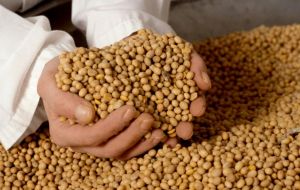MercoPress. South Atlantic News Agency
As world food-prices soar World Bank says it is ready to help countries
 Soy beans have soared 30% in the last two months and 60% since last year
Soy beans have soared 30% in the last two months and 60% since last year The World Bank on Monday said it stood ready to help governments respond to a broad-based run-up in grain prices that has again put the world’s poorest people at risk and could have lingering detrimental impacts for years.
“We cannot allow short-term food-price spikes to have damaging long-term consequences for the world’s most poor and vulnerable,” World Bank Group President Jim Yong Kim said in statement.
“The World Bank and our partners are monitoring this situation closely so we can help governments put policies in place to help people better cope,” said Kim, a public health expert facing his biggest challenge in two months on the job.
A severe drought in the US Midwest has cut projected grain yields dramatically, reviving memories of 2008 when a sharp increase in food prices caused riots in some countries and raised questions about the use of crops to make bio-fuels.
Wheat prices have jumped more than 50% and corn prices more than 45% since mid-June, with dry conditions in Russia, Ukraine and Kazakhstan, excessively wet weather in Europe and a below average start to the Indian monsoon season adding to global crop worries.
Prices for soybeans, a critical food and animal feed crop, also have risen almost 30% over the past two months and nearly 60% since the end of last year.
“When food prices rise, families cope by pulling their kids out of school and eating cheaper, less nutritious food, which can have catastrophic life-long effects on the social, physical, and mental well being of millions of young people,” Kim said. Kim said the bank has a number of programs to help governments should the situation worsen.
Those include policy advice, increased agriculture and agriculture-related investment, fast-track financing, risk management products and work with the United Nations and private voluntary groups to help governments make more informed responses to global food price spikes.
“In the short-term, measures such as school feeding programs, conditional cash transfers, and food-for-work programs can help to ease pressure on the poor,” Kim said. “In the medium- to long-term, the world needs strong and stable policies and sustained investments in agriculture in poor countries.”
World Bank officials stressed there is no indication, based on current crop forecasts, of any major grain shortages resulting from the reduced harvests this year.
In addition, lower prices for oil, fertilizer and shipping than in 2008 will ease the cost of importing food and planting next year’s crop, the bank said.
But Marc Sadler, head of agriculture risk management at the World Bank, said the situation is also “more complicated” than in 2008, when rice and wheat prices rose the most and then fell sharply the next year when plantings increased.
“The difference now is, if you look across the board, all prices are up,” making it tougher for farmers to decide how to allocate their acreage, Sadler said. “When corn prices are up, bean prices are up and wheat prices are up, which one, as a farmer, do you go for?” he said.
Sadler underscored Kim’s point about the threat food shortages pose to a country’s long-term vitality.
“One of the most pernicious facts out there is that in the first thousand days of a child’s life, they develop 80% of their brains. So, malnutrition in those first thousand days has a long-lasting impact”.




Top Comments
Disclaimer & comment rulesCommenting for this story is now closed.
If you have a Facebook account, become a fan and comment on our Facebook Page!